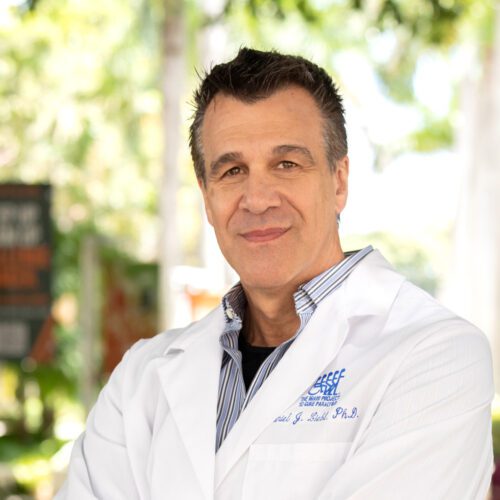Daniel J. Liebl, Ph.D.
Professor, Department of Neurological Surgery

The Miami Project to Cure Paralysis
1095 NW 14th Terrace (R-48)
Miami, FL 33136
Biography
Research Interests
Areas Of Research
Publications
Dr. Daniel Liebl received his PhD from Kent State University in 1994 in Neuroscience in the laboratory of Dr. Peter Koo. He investigated the role of alpha-2-macroglobulin in neuronal growth and survival. In 1994, he joined the laboratory of Dr. Luis Parada and examined the role of neurotrophins and their receptors in developing peripheral and central nervous systems at the University of Texas Southwestern Medical Center.
During his post-doctoral training, Dr. Liebl became a member of the Christopher and Dana Reeves Paralysis Consortium and was promoted to a faculty instructor in 1997. This led to Dr. Liebl’s interest in CNS trauma, and he joined The Miami Project to Cure Paralysis, University of Miami Miller School of Medicine (UMMSM) in 2000 as an Assistant Professor. Dr. Liebl was promoted to Associate Professor with Tenure in 2007 and to a full Professor in 2012 at UMMSM. Dr. Liebl served as Director of the Neuroscience Program from 2008 to 2013 and Associate Director of the MD/PhD Medical Student Training Program (MSTP) in 2020. In 2022, he became the co-Director of the MSTP.
Molecular Mechanisms that Regulate Cellular Dysfunction and Regeneration Following CNS Injury
Our overall goal is to achieve a better understanding of how the injured CNS response to traumatic injury, including brain and spinal cord injury. Protecting the brain and spinal cord from progressive damage and promoting restoration are both important for improving patient recovery. My laboratory has focused on four specific areas of interest: (1) identifying a novel mechanism of cell death; (2) stabilizing synaptic connections and re-establishing new synapses; (3) promoting angiogenesis; and (4) enhancement of adult neurogenesis. To examine these functions, we take advantage of genetic mouse models of traumatic brain injury (TBI) and spinal cord injury (SCI), where we can examine the mechanisms of action within a complex and evolving injury environment using loss-of-function, gain-of-function, and return-of-function approaches. In fact, we take great value in employing a comprehensive set of tools for each of our experimental goals, including molecular, biochemical, genetic, cellular, behavioral, and physiological analyzes as well as high-throughput approaches to identify novel regulators of CNS recovery.
SPECIFIC RESEARCH AREAS OF INTEREST INCLUDE:
- Synaptic Protection and Regeneration: Many of the functional defects associated with CNS injury result from neuronal death that led to synaptic losses; however, there is also a significant amount synaptic damage even when neurons are not lost. This progressive synaptic damage occurs around the injury site but also in distal regions. We have developed a controlled cortical impact injury mouse model that results in synaptic damage in the hippocampus without neuron cell death to examine synaptic stability, de-innervation and re-innervation. We hypothesize that glial cells in the tripartite synapse play an important role in regulated synaptic stability and promoting recovery and test our hypotheses using cell specific inducible transgenic mice. We anticipate our findings will lead to novel therapeutic strategies to protect and promote synaptic function in the TBI patient.
- Dependence Receptor Cell Death: We have recently identified that Eph receptors are new members of the dependence receptor family and have implicate these proapoptotic receptors in CNS injury. In non-pathological conditions, dependence receptors play a positive role in CNS development and/or adult homeostasis upon ligand interactions. However, in the absence of ligand stimulation and following stress, Eph receptors undergo conformational alterations that lead to its conversion to a death receptor. In addition to identifying their roles in CNS injury, we are interested in understanding the signaling cascades, mechanism of induction, and strategies to block Eph-mediated cell death. Our studies will have direct implications on protecting the nervous system for progressive cell loss after injury.
- Intracellular membrane homeostasis: There has been a great deal of research in understanding the overall pathophysiology of CNS trauma, but little understanding of the mechanism that regulate membrane integrity and functions. Cholesterol makes up 70% of a cells membrane and play vital roles in survival, signaling, migration and growth. Much of our current knowledge of cholesterol homeostasis comes the developing nervous system; however, very little is known of how alterations in cholesterol homeostasis affects cellular functions. We employ cutting edge approaches to examine the mechanisms of cholesterol and overall sterol regulation in 2 models; controlled cortical impact (CCI) injury that models traumatic brain injury and experimental autoimmune encephalomyelitis (EAE) is an animal model of multiple sclerosis.
- Adult Neurogenesis: We have recently demonstrated new and novel functions for ephrins and Eph receptors in adult neurogenesis, where they function to maintain proper stem/progenitor cell numbers by regulating proliferation, migration, and survival. Enhancing residential cell replacement strategies provides an attractive approach for stem cell therapy.
Visit Dr. Liebl’s Publication Listing
News Stories
Miami Project Researchers Awarded 5-Year $2.2 Million NINDS TBI Grant (August 2017)
